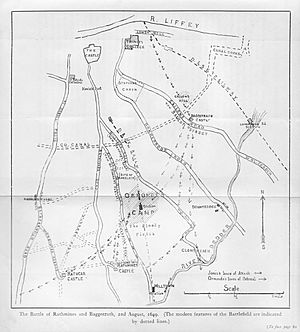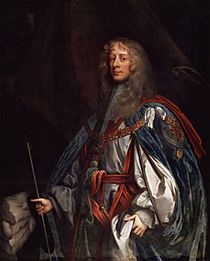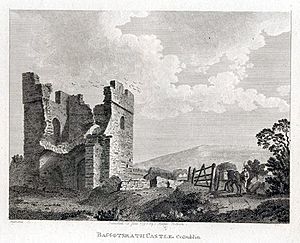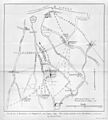Battle of Rathmines facts for kids
Quick facts for kids Battle of Rathmines |
|||||||
|---|---|---|---|---|---|---|---|
| Part of Irish Confederate Wars | |||||||
 Battle of Rathmines, 2 August 1649 |
|||||||
|
|||||||
| Belligerents | |||||||
| Commanders and leaders | |||||||
| Strength | |||||||
| 11,000 | 5,200 | ||||||
| Casualties and losses | |||||||
| 1,000 to 4,000 killed, wounded or captured | Low | ||||||
The Battle of Rathmines happened on August 2, 1649. It took place near Rathmines, which is now a part of Dublin. This battle was a key part of the Irish Confederate Wars. These wars were connected to bigger conflicts called the Wars of the Three Kingdoms. Many people say Rathmines was the most important battle in Ireland during this time.
In late July 1649, a combined army tried to capture Dublin. This army included Irish Confederates and Royalists. Their leader was the Earl of Ormond. Dublin was held by forces loyal to the Commonwealth. These forces were led by Michael Jones.
Even though Ormond's army had more soldiers, Jones's experienced troops won. Many of Jones's soldiers were part of the famous New Model Army. This victory kept Dublin safe for the Commonwealth. It also allowed Oliver Cromwell and 12,000 more soldiers to land easily. This marked the start of the Cromwellian conquest of Ireland.
Why the Battle Happened

The Irish Rebellion of 1641 led to the creation of the Catholic Confederation. This group was based in Kilkenny. From 1641 to 1643, the main fight was between the Confederation and Irish and English Royalists. There was also a separate war happening in Ulster.
In Ulster, a Catholic leader named Eoghan Ó Néill fought against Presbyterian settlers. These settlers were supported by a Scottish army.
In September 1643, King Charles I's commander in Ireland, the Duke of Ormond, made a truce with the Confederation. This truce was called the 'Cessation'. It allowed Ormond to send his troops to England. Over 5,000 of these experienced soldiers went to fight in the First English Civil War.
Fighting continued in Ulster. Some Irish Royalists did not like the truce. They joined the Parliamentarians. These included the Earl of Inchiquin. Others, like Michael Jones, joined Parliamentarian forces in England.
King Charles I surrendered in 1646. But he still secretly talked with the Confederation. He wanted their military help. Ormond did not want the Confederation to capture Dublin. So, in June 1647, he gave Dublin to Jones. Jones was the new governor appointed by Parliament. Ormond then went into exile.
Jones won several battles in Leinster. He stopped Irish forces from getting involved in the 1648 Second English Civil War.
Ormond came back to Ireland in October 1648. He met Inchiquin, who had switched sides again. On January 17, 1649, Ormond and Inchiquin agreed to join forces with the Confederation. Their goal was to bring King Charles back to power.
Ormond's Royalist army included Protestants and English exiles. Many of these exiles were Catholic. There were also a few Irish Catholics. Most of the regular soldiers were local Protestants. Many former English Royalists also joined. Parliament had sent them to Ireland to remove them as a threat.
King Charles was executed on January 30. After this, Ulster Presbyterians joined the Royalist-Confederation alliance. Like many Scots, they believed kings were chosen by God. They saw Charles's execution by the Commonwealth as a terrible act.
Ó Néill then made a separate truce with George Monck. Monck was the Parliamentarian commander in Ulster. London quickly rejected this truce. But it caused a split that weakened the Confederation. It also hurt their alliance with the Royalists.
Soldiers were rarely paid, and supplies were hard to get. So, getting supplies was very important. The Commonwealth had a big advantage because they controlled the sea. People's reasons for fighting were complex. Many groups fought each other at different times.
The Battle of Rathmines
By the end of May, the Royalist-Confederate alliance controlled most of Ireland. They had to use some resources to fight Ó Néill. After capturing Drogheda and Dundalk in June, Ormond moved towards Dublin. He wanted to stop Cromwell from using Dublin for his army. Cromwell was preparing an expeditionary force.
Ormond hoped for help from Prince Rupert's small Royalist fleet. But Commonwealth admiral Robert Blake blocked this fleet in Kinsale.
Jones had fewer than 3,000 men. Ormond's allied army had over 11,000 soldiers. However, Jones's troops were much better trained. On July 22, Ormond arrived outside Dublin. He placed his main force on the south bank of the River Liffey. He sent 2,500 men under Viscount Dillon to attack the Northside.
On July 26, Jones received reinforcements. Four regiments arrived from Chester under Robert Venables. This increased Jones's strength to 4,000 infantry and 1,200 cavalry. Most of these were experienced soldiers.
News also arrived that Cromwell and 9,000 more troops were about to sail from Bristol. An Allied Council of War decided to speed up their plans. On July 28, they captured Rathfarnham Castle. This cut off Dublin's main water supply.
Just after midnight on August 2, Ormond sent 1,500 men. Major-General Patrick Purcell led them. Their mission was to take over Baggotrath Castle. This castle was partly destroyed. It was located where Baggot Street bridge is today. If they held it, their cannons could fire on ships entering the harbor.
For unknown reasons, Purcell took several hours to reach Baggotrath. It was less than a mile from their camp. Jones was alerted by the noise. He understood what Ormond was trying to do. Jones quickly lined up his troops with the Liffey behind them. Ormond told Purcell to make the position safe. He left some cavalry with Purcell, led by Sir William Vaughan. Then Ormond went back to prepare the rest of his army.
However, Jones attacked right away. He scattered Purcell's men and killed Vaughan. By 10:00 am, Jones had taken back the castle. Ormond ordered his troops into battle formation. But Jones kept attacking. He sent his cavalry around Ormond's flanks. They captured Ormond's artillery.
Ormond's advance was briefly stopped by a regiment. This regiment was led by Colonel John Gifford. But Ormond's left side of the army fell apart without fighting. By midday, the battle was over. Dillon retreated to Drogheda. His retreat was protected by 1,000 cavalry. These were led by Sir Thomas Armstrong, an experienced Royalist officer.
Hundreds of Royalist and Confederate soldiers were killed during the chase. Besides Vaughan, the Earl of Fingall was wounded and captured. He died in Dublin Castle a few days later. Ormond claimed he lost between 600 and 1,000 men. Jones reported very few losses for his side. He claimed to have caused 4,000 casualties for the Allies. This included 2,517 prisoners. Historians generally agree that Jones's numbers for Allied losses are likely closer to the truth.
What Happened Next
One of the Royalist officers captured at Rathmines was Richard Elliott. He was Jones's nephew. The long war had created much bitterness. Jones had his nephew executed along with other prisoners.
Jones then quickly tried to use his victory. He marched towards Drogheda. But the town refused to surrender. Jones had to pull back because he did not have enough troops to storm it.
The victory allowed Parliamentarian troops to create a strong defense. This line covered the road between Dublin and the port of Ringsend. Cromwell landed there on August 15. This began the Cromwellian conquest of Ireland.
The Protestant Royalists were divided and discouraged. Many of them deserted in the next few months, including Gifford. Ó Néill then agreed to join Ormond. But their talks finished just before Ó Néill died in early November. His army played a small part in the Parliamentarian campaign. That campaign took back Ulster from September to December. Ó Néill's army was destroyed by Sir Charles Coote the next year at Scarrifholis.
Several places nearby are named after the battle. 'The Bleeding Horse' pub is on Upper Camden Street. It supposedly got its name because its stables were used to treat injured horses after the battle. An area near Milltown was once called the "Bloody Fields." It is believed some of those killed during the chase were buried there.
Images for kids
-
Ormond, leader of the Allied army at Rathmines





